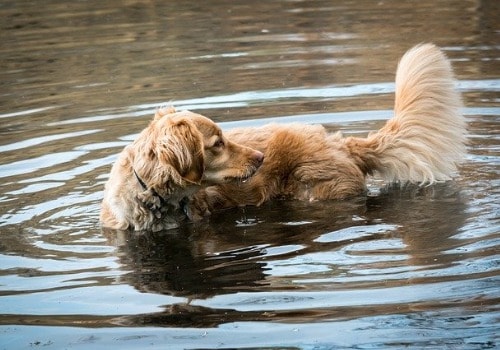What’s the first feature you consider when picturing a dog? For most, it’s the tail.
The wagging of a dog’s tail is an iconic image. But what exactly does this body part offer a dog? And why do dogs have tails in the first place?
This article not only seeks to explain just that, but everything else there is to know about dogs’ tails!
Before looking at the back half of your dog’s anatomy, let’s understand how dogs evolved.
Where Did the Tail Evolve?

It’s a well-known fact that dogs were domesticated from gray wolves who traveled through Europe, southern China, and Mongolia. The Smithsonian pinpoints that this event occurred anywhere between 15,000 and 40,000 years ago through interactions between ancient nomads and an extinct wolf species.
Scientists have theorized about how wolves and humans initially interacted. One such hypothesis is the “survival of the friendliest.” Plainly put, the competition for food lessened when humans and wolves started exchanging protection for food. The wolves would keep other predators at bay and be rewarded by being fed leftovers.
But ideas don’t prove anything. Every theory must be tested.
So in 1999, scientists tested the genetic makeup of the common household dog to their supposed ancestor — which proved that the closest living relative of the domestic dog is indeed the wolf.
Well then, you may ask, why are the tails of domestic dogs different than those of wolves?
Simply put, people are the reason for this variety as we bred dogs (for our own vanity) with curlier, multi-colored tails.
Tail Changes in the Fox
We all know that foxes aren’t domesticated animals. They’re wild and predatory and hunt prey to survive.
So the question is, could a fox be domesticated like a dog?
In the late 1950s, Russian geneticist, Dmitry Belyaev, attempted to do just this. His goal was to only breed “friendlier” foxes.
And what was his discovery? The “tamer” generations started showing different physical features from the wild ones, such as curly tails and different coat colors — the same changes observed in domesticated dogs.
Anatomy of the Tail

A dog’s tail is made of bones. On a basic level, it’s an extension of their spine, though more flexible. They can move it so freely due to the various muscles and nerves that anchor it to the base.
Dog Tail Diversity
There are numerous types of tails found amongst man’s best friend. They vary in shape, length, size, thickness, and color. Provided below is a list of dog tails with an example of each breed associated with that physical feature to give you a better idea of the diversity.
- Natural-born bobbed tails (Jack Russel Terrier, Welsh Corgi)
- Curled or ring tails (Akita, Shiba Inu)
- Sickle tails where it is curled back towards the head (Shih Tzu, Chihuahua)
- Corkscrew (Pug, Shar-Pei)
- Otter or rudder-like tail (Labrador Retriever)
- Tapered or whip tail (Whippet, Great Dane, Bull Terrier)
Why Did the Tails of Domesticated Dogs Change?
The tails of dogs didn’t change organically. Humans shaped their tails into the various forms that we see today.
What Do Dogs Use Their Tails For?
The way a dog’s tail looks does impact the way it’s used. But when you look at the reasons why dogs need tails, there are common themes. Let’s explore them.
Talking With One’s Tail: Dogs Use Their Tails to Communicate
One of the most known reasons a dog needs its tail is to communicate, both with other dogs and their owners. But what people don’t know is that they might be misreading the signs that their dog is trying to show them. The tail can be tricky to decipher when you’re not correctly informed.
When a dog wags its tail, people assume that it is happy. This is not always the case. Whenever you see a tail wag, look at how freely the hind-end moves with the tail. Happy dogs will have a wider wag while shorter, quick movement implies tension.
The placement of the tail is another excellent indicator of canine communication. Tails that stay above the height of a dog’s back indicate either feeling dominant or threatened. A low tail lets you know that a dog is more submissive or fearful.
Communication is a key reason dogs have tails, yet it is not the only one — tails aid dogs in many physical and psychological ways.
Using a Tail for Balance
Tails are an excellent balancing aid for animals of all shapes and sizes. The dog is no exception. Dogs use these appendages in a variety of situations to prevent them from falling.
Working dogs use their tails as a counterbalance while out in the fields. These environments are filled with uneven ground and challenging obstacles. When taking sharp turns to herd sheep, their tails allow them to move swiftly.
Puppies rely on their tails to help maintain balance. During the younger years, a dog is not yet able to walk with full coordination. Although puppies take a few tumbles, the tail prevents even more.
The Warmth of a Tail
Looking at their closest living ancestor, the wolf, it’s easy to see that the tail can provide added protection from the cold elements. Foxes, another distant relative, are also known to use their tails as a blanket, as a domesticated dog would do. Of course, not every dog can use its tail in this way, depending on the type of tail.
Spreading Scent
The spread of one’s scent is important to various species, including the dog. With smell being such an important sense, dogs use their pheromones to leave behind a message. But how exactly do they go about wafting the scent with their tails?
After dogs share their scent, they will wag their tails. This is not out of excitement, but rather dominance. When a dog’s tail is up in the air wagging, it allows the scent to spread, communicating to other dogs that they are nearby and may want to claim that territory as their own.
Why Did Humans Want to Change Dog-Tails?
The reason why humans changed the shape of dog’s tails was for function and purpose.
When hunters began using dogs to locate the birds they shot, they realized that dogs with a rudder-like tail were more quickly able to steer in water and thus get the bird.
Another popular sport was hunting vermin in the fields. Humans decided to use dogs for these events but couldn’t find them as they (the dogs) blended in with the grass. This is why dogs with a flag-like tail were bred. Breeds such as the Basset Hound and Beagle are iconic for their long tails with a white dipstick on the end so that hunters could easily locate their dogs while out in the fields.
Another reason for selective breeding was for frigid climates. In Alaska, sled dogs became a commodity. Unfortunately, dogs with short tails couldn’t survive the winter, so Huskies were bred for their double coats and thick tails, which they draped over their nostrils while sleeping, preventing them from freezing to death.
Docked Tails

Looking at how dogs use their tails makes you wonder about those who don’t have one. There’s a difference between tails that are bobbed or docked.
A few dog breeds are naturally born with a bobbed tail, such as the French bulldog, Welsh corgi, and Boston terrier. As for those who have docked tails, humans perform this surgery.
How a tail is docked has become controversial in more recent years, as it doesn’t appear to be humane. The process involves removing some or part of a dog’s tail, typically in the earlier stages of life when it is less painful. Some think that the advantages outweigh the cons.
Some herding breeds, such as the Australian shepherd, have their tails docked to help prevent future injuries. With the loss of a tail, the dog is unable to use this appendage for balancing. Instead, they learn how to use their hind legs to balance, making for a stronger, more capable herding dog. There are risks involved in tail docking.
One way in which a docked tail can become problematic is when they develop nerve tumors or a pinched nerve (also known as a neuroma). Other risks involve chronic pain, inflammation, and infection.
Final Thoughts
A dog’s tail is used for a variety of reasons including, but not limited to communication, warmth, spreading their scent, and balance. It has changed over time with the domestication of the wolf, ranging in shape and length. Overall, it’s evident that man’s best friend has a little friend of their own.
